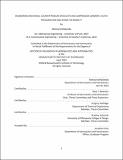Engineering Mechanical Counter Pressure Spacesuits and Compression Garments: Active Pressurization and Design for Mobility
Author(s)
Kothakonda, Akshay
DownloadThesis PDF (4.086Mb)
Additional downloads
Advisor
Newman, Dava J.
Terms of use
Metadata
Show full item recordAbstract
Extravehicular activities (EVA’s) are an essential and integral part of human exploration of space, with their use ranging from performing scientific experiments on a planetary surface to assembling space stations. Spacesuits must provide an astronaut with the conditions necessary to survive an EVA for several hours and to enable them to carry out these complex tasks. One of the main factors impeding the effectiveness of EVA operations is the stiffness of the spacesuits, which is inherent in gas pressurized suits. While there have been several engineering advances in improving the mobility of gas pressure suits, a mechanical counter pressure (MCP) suit seeks to significantly improve mobility and minimize metabolic workload by replacing gas pressure with contact pressure of a tensioned fabric against the body. Although a marked improvement in mobility of MCP suits over traditional gas pressurized suits was demonstrated in the 1970’s with the Space Activity Suit, engineering challenges remain before this such a suit can be used operationally. Applications of the MCP suit concept extends to compression garments for athletic and medical use. This thesis seeks to address some of the fundamental requirements of an MCP suit. These include providing uniform MCP of 29.6 kPa over the body, minimizing mechanical work during suited movements, and enabling easy don and doff. While the thesis focuses on the single degree-of-freedom arm section of the suit, the work can be extrapolated to the entire body. The bidirectional actuation of two-way Shape Memory Polymers (2W-SMP) is leveraged to both provide MCP and allow for easy don/doff. This is achieved by reversing actuation via thermal stimulus. Two designs of MCP suit as an assembly of suit fabric, 2W-SMP, and elastomers are conceived and analysis is carried out to select the more feasible design. On the selected design, analysis is conducted to select a 2W-SMP with maximum MCP for a given donning effort. Two types of suit fabrics are analyzed in the design- the woven fabric and the jersey knit fabric. Nonlinear finite element analysis (FEA) models that can be used to analyze the deformation of these fabrics under suited movements have been developed. Results from these simulations are hoped to aid in designing the fabric in a such a way that sustains circumferential tension of 2 the 2W-SMP and minimizes mechanical work during movements. While the former would require the fabric to be stiff along the circumferential direction, the latter can be achieved by aligning the compliant axes of a given fabric with the directions of first principal strain. The process of estimating the optimum fabric pattern will be iterative and the resulting pattern may comprise of a composite of different fabric types with varying parameters. Mapping skin Lines of Non-Extension (LoNE’s) informs contours for inextensible cables in such a way that they do not impede movements. These cables may form part of suit life support system. This thesis focuses on developing tools such as methodology for sizing SMP’s, fabric models, and LoNE’s and as such does not use those tools to arrive at an optimum suit design. Utilization of these tools towards suit design is one of the future tasks in this work. Additionally, the author expects that future research efforts in this area at large will benefit from these tools. The thesis includes an introduction of the problem and the motivation, background and literature review of relevant concepts, a deep dive into analysis and tests on shape memory polymer materials and their use for compression devices, development of fabric numerical models, and finally a discussion of the work and a summary of contributions.
Date issued
2024-05Department
Massachusetts Institute of Technology. Department of Aeronautics and AstronauticsPublisher
Massachusetts Institute of Technology